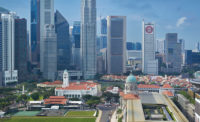Singapore
W Architects and Lighting Planners Associates
Singapore may be a tiny city-state, but its rich culture incorporates multiple ethnic groups, and its complex history stretches over several centuries. The National Museum of Singapore proudly showcases this heritage inside a Neoclassical building and a year-old, glass-and-steel addition.
Designed by Colonel Sir H.E. McCallum, the museum first opened in 1887 when Singapore belonged to the British Straits Settlements. In 2000, the government decided to double the museum’s capacity and update its contents without demolishing previous expansions. While government designers handled restoration, the local firm W Architects spearheaded the new construction. Concentrating on the building exterior, Lighting Planners Associates (LPA) of Tokyo and Singapore used the tricks of their trade to help join the two.
Spanning two of the city’s major green spaces, the museum today comprises 198,000 square feet distributed among three parallel, linear blocks. The original building faces Bras Basah City Park. It is followed by an early-20th-century addition and then the most recent construction, which overlooks Fort Canning Park. The existing components contain restaurants, shops, and offices on the ground floor and thematic galleries upstairs. The new part holds the children’s discovery gallery above ground, the history gallery in its first basement, and temporary galleries and a 250-seat auditorium in its second basement. In a gesture that is both architectural and urbanistic, a perpendicular corridor links the layers and, conceptually, connects the parks.
Although this corridor predated the new construction, it was W Architects’ bold idea to replace its solid roof with glass, providing museumgoers with unobstructed views of the magnificent, zinc-tiled rotunda that crowns the original building. Where the historic structure ends, the corridor becomes a bridge that culminates at the W Architects–designed addition’s top level. “We did not want old and new to simply stand next to each other,” explains principal Mok Wei Wei. “We wanted physical engagement.”
Because the height of the new construction could not exceed the dome’s spring line, the architects concentrated the program underground, turning its above-ground space into a glorified circulation concourse flanked by the perforated-metal children’s wing as well as a glass drum descending to the history gallery. Cut into the concourse floor, a metaphorical canyon connects to the lowest level: Reminiscent of the earth’s layers, walls of concrete-and-granite-chip panels define this deep and narrow incision.
Reinforcing the museum’s stratified plan, LPA’s lighting scheme changes progressively from the old building to the new and from day to night, reaching its peak in the early evening hours when the museum is still open but the sun has set. Highlighting the original building’s ornate facade, flat, compact-fluorescent floodlights create gradated illumination along its base and xenon strip fixtures draw attention to its windows, columns, cornices and pediments. Ringed with fluorescent uplights and two rows of neon, the dome simply glows.
By contrast, natural light fills W Architects’ addition, although in the evening, metal-halide lamps bathe the entire surface of the old building’s rear elevation (now the addition’s inner wall) from above. Playfully uniting new and old, tiny blue LED fixtures line the top of the wall and adorn the drum. Visible through the transparent enclosure, the warmly illuminated wall remains on display long after the museum closes, while the addition practically fades into shadow.
Together, LPA’s lighting and W Architects’ architecture imbue the antique building with new life. Turning it into an artifact as well as a work of architecture proudly elevates the institution and honors the cultural history it embodies.
PeopleLighting Designer: Lighting Planners Associates 5-28-10 Jinguame Shibuyaku Tokyo 150-0001 Japan ph: +81 3 5469 1022 fx: +81 3 5469 1023
Project team: Kaoru Mende, Mari Kubota, Emiko Nagata, Yah Li Toh
Architect: W Architects 170 River Valley Road #05-06 Singapore 179033 ph: +65 6235 3113 fx: +65 6733 3366
Project team: Mok Wei Wei, Nui Ratiwat, Goh Wei Kiat, Joan Loo, Tng Choon How
Architecture and engineering consultant: CPG Consultants
Project Manager: PM Link
Restoration Works: Architectural Restoration Consultants
Facade Consultant: Connell Wagner
Acoustic Consultant: CCW Associates
Landscape Design: ICN Design International
Signage: Duet Design
Photographers: Albert Lim K.S. Frank Pinckers Tim Griffith Toshio Kaneko
General Contractor: Sato Kogyo (S)
architecture — Jean-François
Milou, lead architect; Wenmin Ho,
Thomas Rouyrre, architectural
team managers; Charmaine Boh,
Janis Goh, Trung Thanh Nguyen,
Jason Tan, Jiarong Goh, May Leong,
Eudora Tan, architectural designers
|
ProductsExterior Floodlights: Erco
Interior metal-halide lamps: Erco
|






Post a comment to this article
Report Abusive Comment